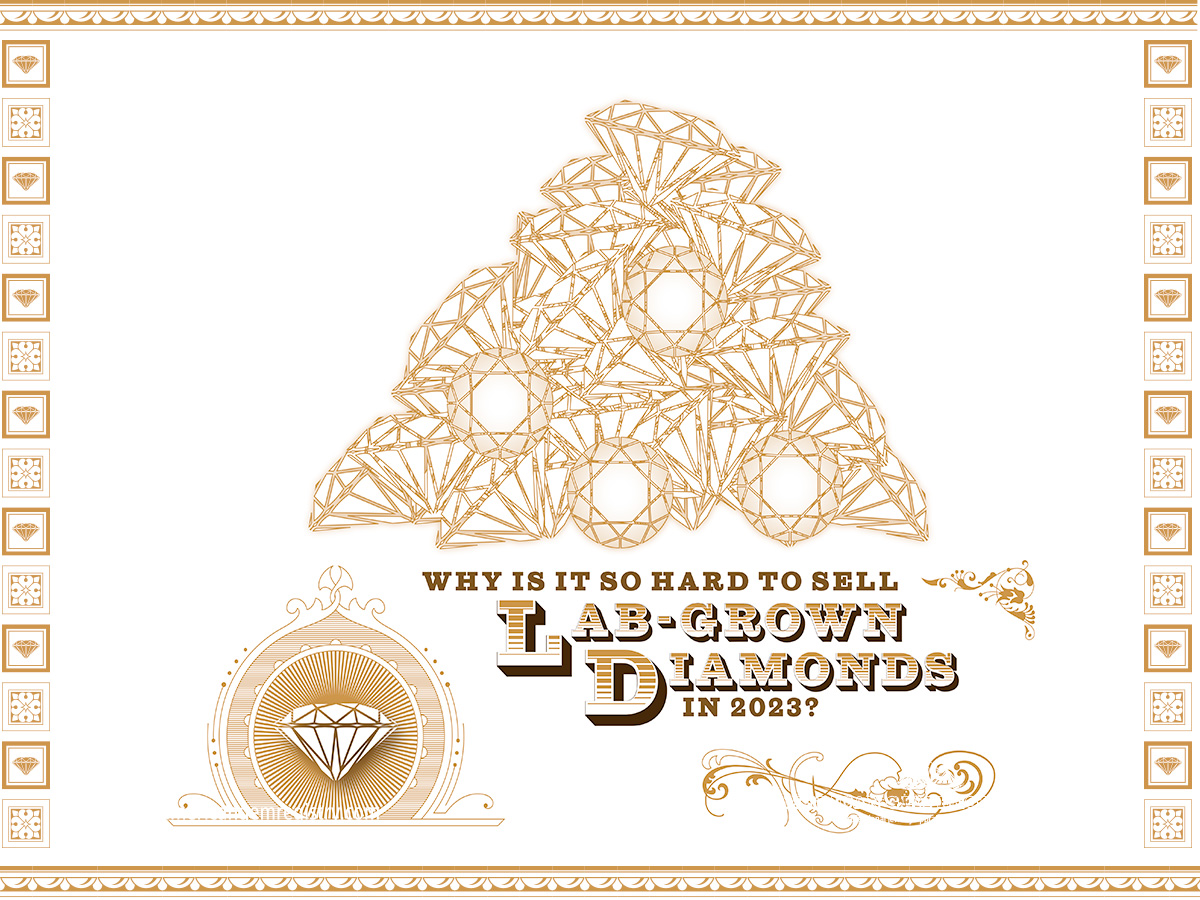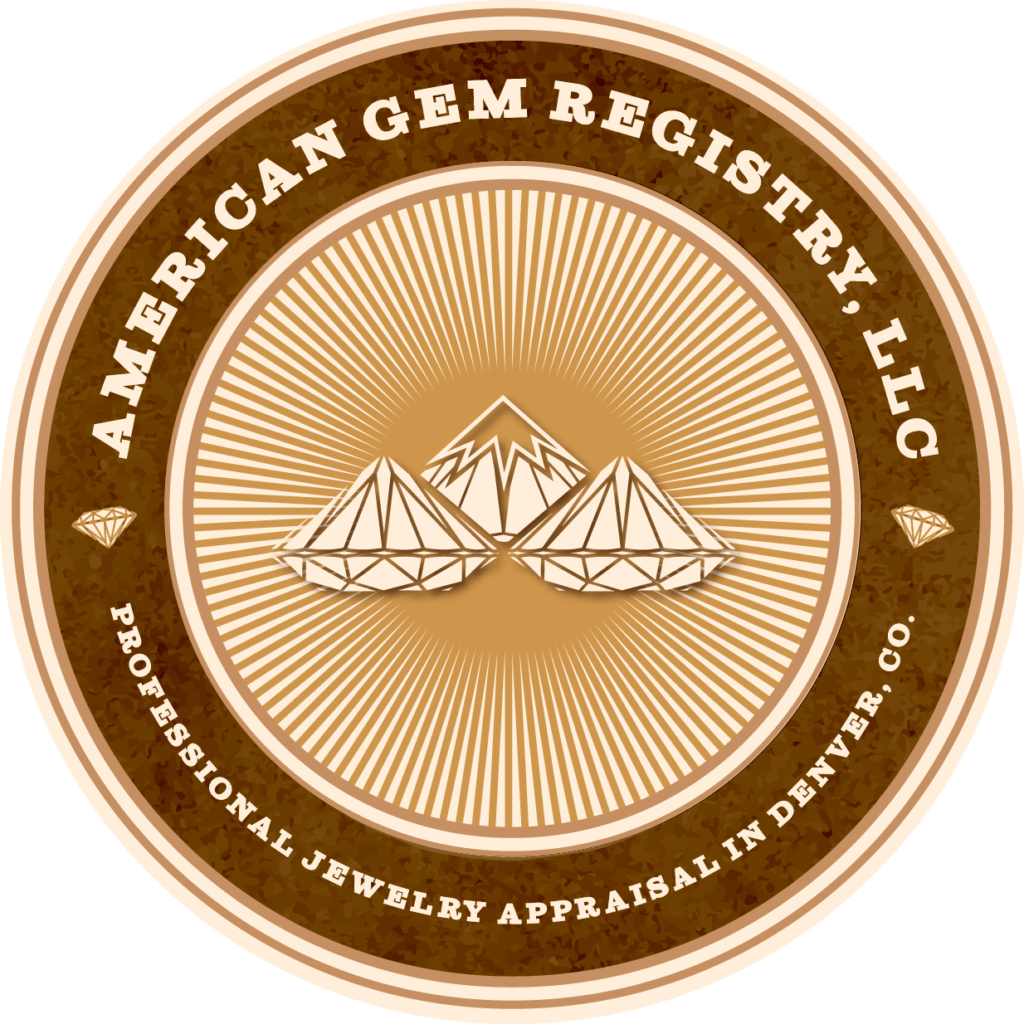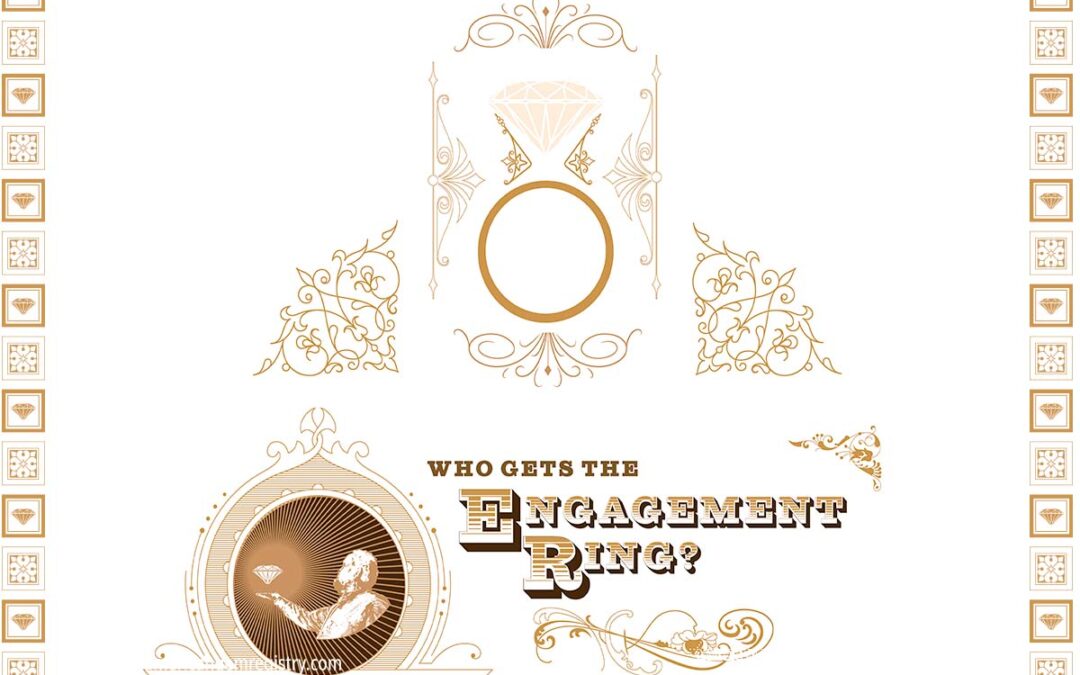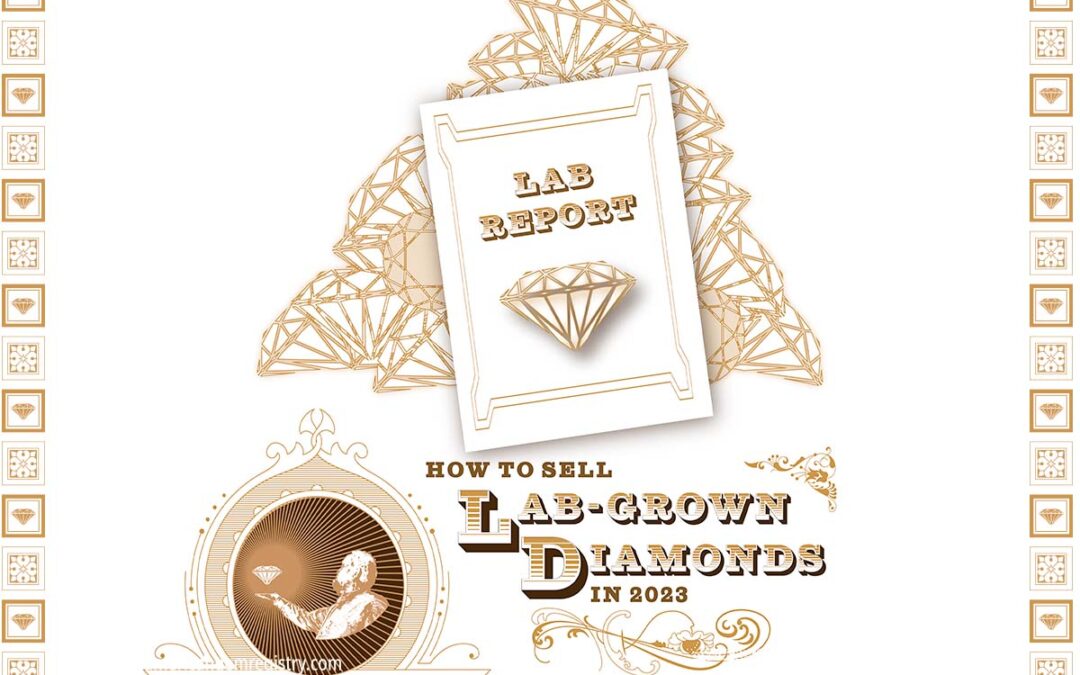Have you noticed that it’s getting harder and harder to sell lab grown diamonds? This is a tale about how Lab Grown and Natural Diamonds hold their value, with some pointers on how to sell the former in 2023.
Summary
- People trying to Sell Lab-Grown Diamonds find the prices have dropped by over 50% in the last year.
- “Store of Value” is an Economics term which relates how well a given object maintains, gains, or loses monetary value over time.
- One of the selling points of Natural Diamonds is that they hold their value better than Lab-Grown Diamonds.
- Even with Natural Diamonds, calculating the Present Market Value of a piece of jewelry purchased a decade ago isn’t as simple as taking the value at time of purchase plus inflation over the time period.
- The value of Natural Diamonds goes up over time, albeit slowly.
- Lab-Grown Diamonds are a product of technology: With every technological advancement, the value of the old version goes down.
- The traditional resellers of diamonds are unfamiliar with LGDs, making the secondary market for LGDs limited.
What is a Store of Value?
“Store of Value” is an economics term which usually means ‘any commodity or asset that would normally retain purchasing power into the future.’ A house, for example, as well as all land, generally gains in value over time. A car, on the other hand, loses value the minute you drive it off the lot and continues to do so over the lifetime of the vehicle. A house is a good store of value, a car is not. (Though, ironically, you usually need the car to go to the job to afford the house.)
One of the selling points of Natural Diamonds is that they hold their value better than lab-grown equivalents. While that IS true… it is hardly an endorsement.
I’ll start with Natural Diamonds.
Natural Diamonds as a Store of Value
I just did an inspection for a Natural Diamond that was purchased in 2013 for $8314.00, retail new, at one of the big and well regarded jewelers in town.
The client is getting a divorce and needs an appraisal of what they can reasonably expect to sell the piece for in 2023, along with a comparison appraisal of what they could have reasonably expected to sell it for in 2013. The two separate appraisals help divide property in an equitable way. Lawyer stuff.
The original seller ring gave a ‘free appraisal’ for $9700.00. It’s a pretty standard solitaire ring with a GIA-graded diamond and nothing much else. It was about as mainstream as you could get..
The client’s expectation was a simple calculation. The original cost of the ring plus ten years worth of inflation. ($9700 plus inflation for 10 years.) Assuming appreciation at 10%/year, $9700 in 2013 would come to about $25,000 now. Cool!
Unfortunately, that’s not how it works.
Factors Affecting the Value of a Natural Diamonds Over Time
Even with Natural Diamonds, calculating the Present Market Value of an object purchased a decade ago isn’t as simple as taking the value at time of purchase plus inflation over the time period.
Here’s why:
Usual and Customary MarketPlace
That initial appraisal was an estimate of how much it would cost to replace the piece of jewelry with another like it in the case of a loss, at retail, new, and in the ‘usual and customary marketplace’. (Mostly, that means a specialty jewelry store in the local area, in this case.)
This is a big world. There are lots of jewelers. The tricky part is deciding what is ‘reasonable’. That’s why the value conclusion on replacement appraisals is typically more than the transaction price, even when it’s at the same stores. In this example, $1500 more than the transaction. The idea is that the appraisal covers most stores.
New Versus Used
Like everything else, ‘new’ and ‘used’ are importantly different issues. Just because a fancy store can get $8300 for a piece new doesn’t mean that YOU can. In fact, you almost certainly can’t. But that’s for new. What about used?
Assuming you don’t happen to own a jewelry store, you’re probably going to sell your used piece of jewelry to a professional buyer. Even if you can sell the piece to one of your friends or relatives and get all the money, that’s not the ‘usual and customary market.’
‘Usual and customary’ for a second-hand diamond ring is a dealer who trades in this sort of thing locally. A pawnshop. An antique store. One of those guys on the side of the road with spinning signs that say ‘we buy gold and diamonds’. (Hint: None of these pay retail. Get an independent appraisal.)
Used Engagement Rings
The new ring imagined above contains a lot of value elements that don’t apply after it’s purchased, like a new vehicle. People don’t like used engagement rings, for example. It’s a symbolic thing.
That means the labor to set the diamond becomes labor to remove it. Sales tax and shipping are gone and you’ll never get it back. That new GIA lab report and shipping are going to come off the top.
Even in near mint condition, the pawn shop is only going to give you the weight of gold for the mounting. They’re almost certainly going to take the gemstone(s) out and sell them separately, after updating the report. The mounting is going to go in the melting pot.
The Actual Cost of the Piece Includes More Than the Diamond
The actual cost of the ring in question when it was new was really $7200—not $9700 or even $8314. This is the actual cost of the labor, the ‘free’ appraisal, sales taxes, etc., that were used in making the piece, in addition to a Natural Diamond with a GIA lab report. The client originally paid $8314 for all of this.
For those curious, that leaves $1,114.00 as gross profit… the jewelry that crafted the piece still needs to pay for electricity and food and marketing. This is all to say that the diamonds and gemstones are only a part of the cost.
Liquidation Value
The buyer is doing this for money. They’re going to have about $300 in direct costs in order to make a used piece saleable (assuming it’s undamaged. It may be more,) and they’re going to want to pay about half… about $3400, because they plan on making money on this deal. Maybe less than they originally intended.
That’s going to be the 2013 orderly liquidation value, or at least close to it.
The Actual 2023 Appraised Value
What about the 2023 value of the ring imagined above? Using the same sorts of math and even the same general sources, current expected resale for a decently skilled shopper on that diamond is about $3900.* Retail new on the piece would be about $9,000, plus tax/shipping/setting/appraising, etc. Call it $10,000.00.
The 2013 Appraised Value Versus the 2023 Appraised Value of a Natural Diamond
Remember, at the beginning of this, our client originally bought the ring for $8314.00 in 2013.
The seller of the same ring included a ‘free’ appraisal for $9500—1200 more than the actual price to allow for “reasonable variations and usual and customary market place estimates.”
Based on this information, the client originally expected the value of the ring (based on the appraisal) to grow to $25,000 by 2023 at 10% growth per year. However, the actual 2023 appraised value comes in at $10,000.
That means, in this example, a ring with a Natural Diamond purchased for $8,300 in 2013 appraised at just around $10,000 in 2023.
Viewed as an investment, that’s a loss of 50% over 10 years not counting carrying costs like insurance, repairs and storage. That doesn’t make it a bad buy—people buy diamonds for completely different reasons—but that’s a dreadful ROI if you’re thinking of it as an investment.*
What About Lab-Grown Diamonds as a Store of Value?
Lab-Grown Diamonds (LGDs) have most of the same issues as their natural cousins, but with one important difference: The market value is declining, not rising. Put more bluntly, Lab-Grown Diamonds are perishable, which makes them hard to sell after their prime.
In the above story, the Natural Diamond went UP over 10 years. It wasn’t the story the customer expected, but it still went up. Most of the apparent decline over time was on the first day, like with most retail purchases, but the gemstones themselves do retain some value.
Lab-Grown Diamonds are a Product of Technology
The value of LGDs is going down. It’s a tech product and those always go down. In the last year, most LGDs have dropped by more than half. Some by a fair amount more.
Think of the resale value of your iPhone 3 that cost $500 new, and you may have stood in line for several days to buy. The moment the iPhone 4 was released the resale value of your iPhone 3 dropped sharply. Then the iPhone 5 came out several years later and the resale value of your 3 dropped to nothing at all.
It is the same with LGDs. Lab-Grown Diamonds are literally grown from electricity. Every time there is a technological advancement in, say, power production, it becomes easier to gather the volts necessary to grow said diamonds.
That causes some important changes in the market. The dealers buying for you need to hedge for the future. The Lab-Grown Diamond may be worth $3000 to them today—but it’s likely to take a while before they can sell it. The market price of LGDs will likely drop with the next technological advancement, and they have no idea how much or how fast.
The Sellers of LGDs are aware of this. They want to sell their current stock of LGDs as fast as possible to hedge the likelihood of the market price dropping while they’re holding their inventory, just like Best Buy wants to sell its newest shipment of computers before Intel or Apple design a faster machine.
Lack of Familiarity Amongst Resellers
The next unique issue to selling lab-grown diamonds is familiarity—or lack of it.
Most secondary market dealers, like pawn and coin shops, have been in the diamond business for a long time. It’s a major piece of their businesses and they know how it works. They’ve done this deal before. A lot of them sell more diamonds than the jewelry stores do.
Lab-Grown Diamonds are a new proposition. They’ve only been a serious product since about 2010. Before that, they were a scientific curiosity. Even telling the difference between natural and lab-grown diamonds can be a challenge for those unfamiliar with the process. (Yes, it is possible, even easy, with the right equipment. Word to the wise: It would be foolhardy to try to sell a lab-grown diamond as a natural one.)
The value of LGDs is still in flux for resellers. What is going to be popular and how fast they’ll sell isn’t firmly known. Employees don’t understand them and, frankly, the advertising contains a LOT of baloney. That means more risk, and more risk means paying lower prices. This means that the traditional resellers of natural diamonds are hesitant to do the same for labs.
Reputational Damage
Lastly, there’s the reputational damage this can cause. As reasonable as it is to explain to people who will read an essay like this, the reality is that nearly everyone is upset when they learn that the new ring with the LGD they paid $10,000 for last year is only going to bring them $1,000 on resale, and that it’s going to be hard to sell at that.
Now let’s say we’re talking about the same store or one that’s been there for decades. Buyers of expensive new jewelry don’t want to hear excuses. They wanted money for an asset that gained in value (not lost most of it,) so they just storm out thinking the store, and the industry, are all a bunch of crooks. The store not only doesn’t get the buy, they lose a customer in the process, and potentially a bad review. Lose/lose.
The simple solution for the original retail sellers of jewelry is to not buy used lab-grown diamonds from the public at all. It’s not worth it. Don’t bid, and just blame it on the home office policy or something. Let the pawnshop take the slings and arrows.
Why is it So Hard to Sell Lab-Grown Diamonds?
The reason it’s hard to sell Lab-Grown diamonds in 2023 is pretty simple: They are a product of technology, and with each technological advancement, their value goes down, less-expensive products are continually introduced into the market. And, as a product of technology, they are pretty new—Lab-Grown Diamonds have only been commercially viable since about 2010. With an expectation of declining value along with unfamiliarity with the product makes it hard for the traditional resellers of diamonds to get their footing.
While Lab-Grown diamonds are considered a more ethical source of diamonds overall, they lose their value almost instantly, and are expected to continue to do so for quite some time. So LGDs are a wonderful symbol, they aren’t the best store of value.*
*No part of this publication should be construed as an appraisal, valuation, or financial advice. All figures are used for educational purposes only.
Do You Need A Jewelry Appraisal in Denver, Colorado?
The American Gem Registry provides a variety of jewelry appraisal services in Denver, Colorado:
- Gem and Jewelry Appraisals
- Estate Evaluations
- Expert Witness
- Pre-Custom Consultation
- Re-Cut Consultation
- Damage Consultation
- Restoration Evaluation
- Fair-Market Value Appraisals
- Insurance Appraisals
If you have any questions, please call during my normal business hours at the number below. Or, you can schedule your Jewelry Appraisal Appointment online today!








